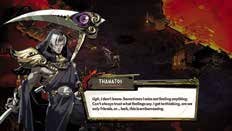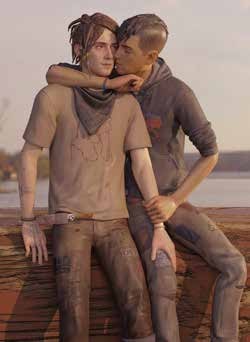Along for the Adventure
As the gaming world introduces new, diverse characters, it’s turning into an ideal space for LGBTQ+ storytelling
By Matthew Bradford

Flores from Tom Clancy’s Rainbow Six Siege (Ubisoft)
Queer characters and narratives have long vied for space in popular entertainment. And while video games have a less-than-stellar history of LGBTQ+ representation, the medium is levelling up.
“Games are an interesting medium for representation because there are a lot of different types of dynamics between the player and their character,” suggests Adrienne Shaw, author of Gaming at the Edge: Sexuality and Gender at the Margins of Gamer Culture and associate professor at Temple University’s Department of Media Studies and Production.
Still, adds Shaw, “to say the industry has matured would make it seem like it needed to go through a revolution process to think about representation, and that’s giving the industry as a whole too much of a pass.”
The opportunity for gamers to step outside their known worlds and plug into different experiences makes video games an ideal space for LGBTQ+ storytelling. Yet after 60-plus years of immersing players in the lives of soldiers, street fighters, space marines and princess-savers, it’s only in recent years that game developers have explored non-heteronormative themes in a meaningful way.
“The game industry started at a time when, at least in the U.S., critical conversations about media representation were already present and on the rise,” says Shaw. “There is no reason that once game makers started putting humans or human-like characters in games that they couldn’t be critically aware of what that representation looks like.”
It took longer than it should have for the gaming industry to broaden its horizons. Aside from scarce (and understated) exceptions, women, people of colour, Indigenous and LGBTQ+ characters enjoyed little screen time after video games entered the scene.
Promisingly, there are signs that the medium is making up for missed opportunities, with underrepresented demographics stepping up to feature roles in many mainstream titles. One could argue that the industry is merely following the money (according to a Nielsen study, LGBTQ+ gamers represent half of the community and spend eight per cent more than their peers), yet a more optimistic view is that the industry is embracing its potential as a diverse and impactful storytelling medium.
A BRIEF HISTORY
The evolution of LGBTQ+ storytelling in video games is similar to its growth in other entertainment media: slow to start, subtle at best, and prone to stereotypes and cliches. In fact, it took 14 years from the first commercially available video game Computer Space for the first hint of same-sex relationships to appear. This was in Moonmist, in which a main character is subtly described as a “female artist who is also a criminal [and] was jealous about her girlfriend marrying a man.” The following years saw marginal progress for LGBTQ+ representation. Developer CM Ralph coded the very first LGBTQ+ game – an interactive detective adventure Caper in the Castro – while the first transgender women appeared in Westwood Associates’ Circuit’s Edge that same year. Then, in 1998, the postapocalyptic role-playing game (RPG) Fallout 2 became the first in its medium to give players the option to marry a same-sex partner.
“ To me, there’s an opportunity here to give players an experience that will expose them to views and lifestyles they might not see in their day-to-day lives. ”
-SIMON DUCHARME UBISOFT MONTREAL

GLAAD AWARDS
In 2018, the Gay and Lesbian Alliance Against Defamation (GLAAD) added an Outstanding Video Game Award to its annual GLAAD Media Awards. 2021 nominees included:
> Assassin’s Creed Valhalla (Ubisoft)
> Borderlands 3: Guns, Love, and Tentacles (2K Games)
> Bugsnax (Young Horses) > Hades (Supergiant Games)
> If Found… (Annapurna Interactive)
> Ikenfell (Humble Games/ Happy Ray Games)
> Immortals Fenyx Rising (Ubisoft)
> The Last of Us Part II (Sony Interactive Entertainment)
> Tell Me Why (Xbox Game Studios)
> World of Warcraft: Shadowlands (Blizzard Entertainment)

Finding unspoken love in the underworld in Hades (Supergiant Games)

Ellie and Dina share a moment in The Last of Us Part II (Naughty Dog)
CREDIT: SONY INTERACTIVE ENTERTAINMENT
“We kind of liked pushing boundaries a bit. Not always with violence – we wanted a game which is full of social commentary. So [same-sex marriage] was just another thing we were doing,” Tim Cain, creator of the Fallout series and an openly gay developer, told The Daily Dot. “I don’t even think anybody in the team really argued over it. We didn’t think, ‘Oh my god, this is an amazing thing.’ It was just, ‘We’re going to cover every possible base here.’ And then we moved on.”
The momentum continues today. Same-sex relationships have become a de facto option in franchises like The Sims (EA), Mass Effect (BioWare) and Assassin’s Creed (Ubisoft), while LGBTQ+ characters and narratives have taken the spotlight in best-selling titles like The Last of Us Part II (Naughty Dog), Life Is Strange (DONTNOD Entertainment), Stardew Valley (ConcernedApe) and Hades (Supergiant Games).
According to Supergiant Games creative director Gavin Kasavin, “We do our best to imagine our characters as completely as possible, where aspects like their sexuality or gender identity are just a part of who they are. What’s appealing to us about having a big cast of characters is for each of those characters to be distinct in voice, manner and worldview, while together creating a cohesive sense of the world they’re from and the values of that world… Works of fantasy and science fiction have an opportunity to imagine worlds with values or social orders different from the world we live in, in both large and subtle ways.”
RECODING REPRESENTATION
Video games haven’t always handled queerness with respect. Gaming shelves are filled with overly flamboyant characters, “deviant” homosexual villains or gender-swapping scenes played off for laughs. Promisingly, industry talents like Simon Ducharme, a narrative scriptwriter at Ubisoft Montreal, is among a growing number of game makers that have helped bring richer, more realistic LGBTQ+ stories to the screen.
“Representation matters in gaming, as it does anywhere else,” says Ducharme. “To me, there’s an opportunity here to give players an experience that will expose them to views and lifestyles they might not see in their day-to-day lives and help them be kinder when they encounter different people in their lives and gaming space.”
Ducharme and his team were instrumental in bringing two LGBTQ+ characters to the online tactical shooter Rainbow Six Siege: Flores, a master thief and the game’s first gay character, and Osa, a tech specialist and the title’s first trans woman. “I was very happy to be assigned to these characters,” he says. “The fact is there is a fairly large community of queer gamers who play Siege, so it makes sense that if we’re going have a diverse cast that there will be queer people in the cast.”
Ducharme says that bringing Flores and Osa to Rainbow Six Siege’s vast online community in a respectful and meaningful way was a priority for Ubisoft. “It’s important to speak to the people we’re trying to represent,” he notes. “By example, we spoke to Dakota women when designing our Indigenous character Thunderbird, and for the same reasons we spoke to trans women when creating Osa… And they were there for every aspect of Osa’s development, from the writing to concept art and modelization. They were even made aware when we cast Nicole Maines, a trans woman, to play Osa, who did a phenomenal job.”
It’s a learning process, stresses Ducharme, but it’s supposed to be. Without meaningful engagement with the communities that developers are attempting to represent, there is a risk of falling back into lazy stereotypes or narrative shorthand that ends up betraying their best intentions.
For example, says Shaw, “The number-one problem, outside of blatant homophobia and transphobia, is having LGBTQ+ characters exist in isolation. In some fantasy games, for example, you’ll only come across one or two LGBTQ+ characters in that whole universe. That’s why showing LGBTQ+ people as part of broader communities of LGBTQ+ people is an important first step toward meaningful representation that doesn’t feel like tokenism.”
Favouring perfection over realism can also dull the impact of queer representation. As Ducharme notes, “Sometimes, we can forget that the goal is to create people. So if you’re trying to people please and make a character too perfect, that simply isn’t going to work in a solid narrative... Good intentions go a long way, but they’re not everything.”

Finna and Shawn from Life is Strange 2 (DONTNOD Entertainment)

Dorian the mage braves mythic creatures and real prejudices in Dragon Age: Inquisition (BioWare)
PUSHBACK
Even after years of social progress, there is a small but (frustratingly) vocal community that continues to push back against games that venture outside their view of “normal.” “For me, the strategy is to combat those with persistent kindness,” says Ducharme. “No matter how negative the response or question might be, I try to come at it from a positive place of education. When people say, ‘don’t put politics in my game,’ I try to remind [them] that our existence as people isn’t political in nature. These characters are essentially the same as the rest of the cast, except they are queer. That has nothing to do with politics.”
The resistance to LGBTQ+-themed games is less prevalent in the independent developer space, i.e., in the indie gaming world. Here, games like Dream Dad: A Dad Dating Simulator (Game Grumps), A Summer’s End -Hong Kong 1986 (Oracle and Bone), If Found… (DREAMFEEL) and Boyfriend Dungeon (Kitfox Games) are often received by smaller, more supportive audiences.
Satoru Iwata, a gaming industry legend and former Nintendo boss, once said, “Video games are meant to be just one thing: fun! Fun for everyone.” This simple quote remains true, but only if the gaming community continues to take all players along for the adventure. As Ducharme explains, “Visibility is central to representation and education. People looking at these things from the outside… may not be very familiar with issues and identity, but when they see it on their screen, they learn about it, get used to it and hopefully become more positive about it.”